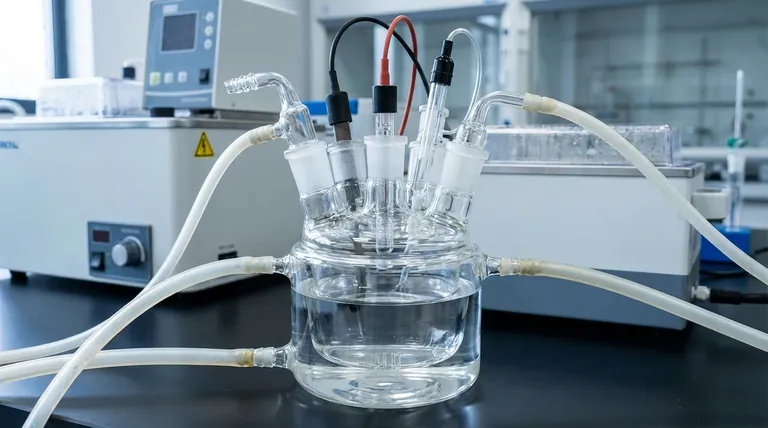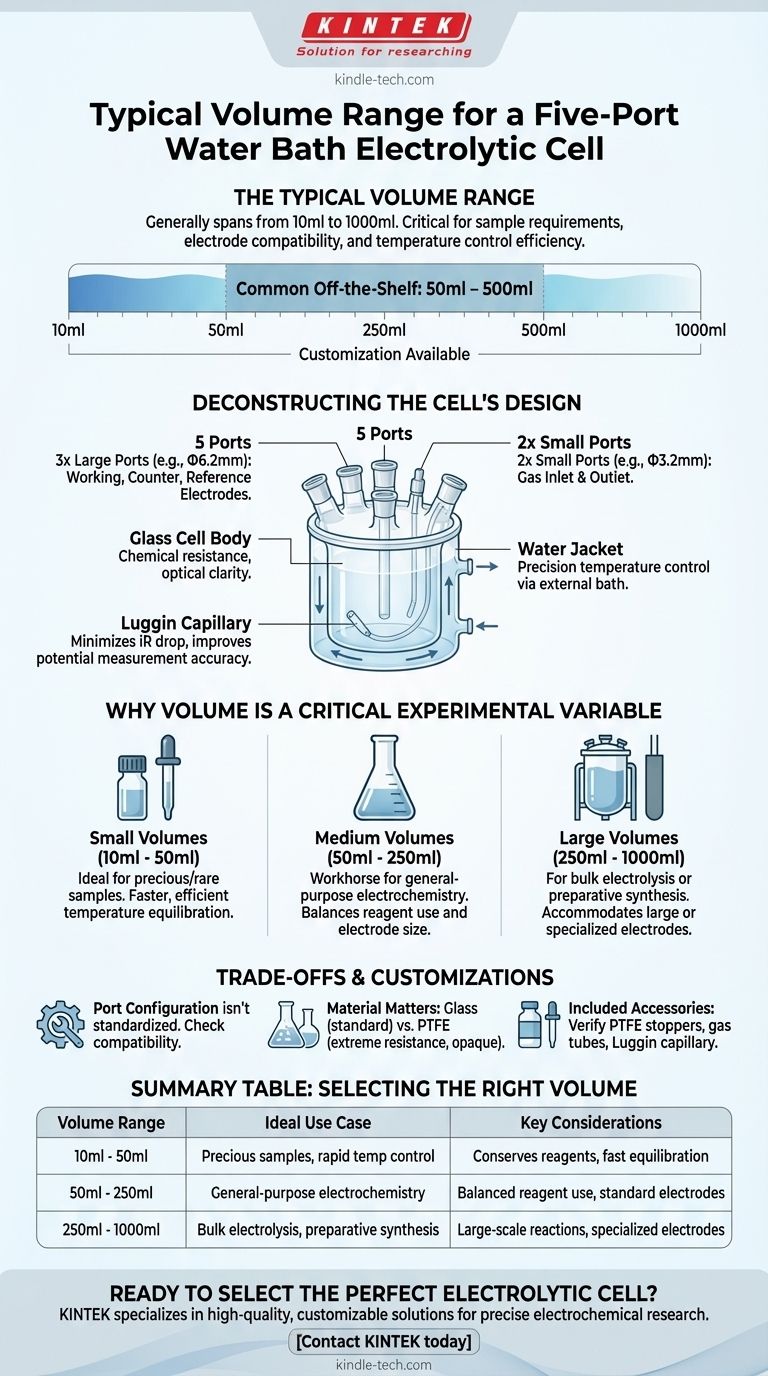For a standard five-port water bath electrolytic cell, the typical volume range is quite broad, generally spanning from 10ml to 1000ml. While this full range is available, many common off-the-shelf models are often concentrated in the 50ml to 500ml range. Nearly all suppliers offer customization for volumes outside these standard specifications.
The specific volume of an electrolytic cell is not just a specification; it's a critical experimental parameter. Your choice, from small (10ml) to large (1000ml), directly impacts sample requirements, electrode compatibility, and the efficiency of temperature control.

Deconstructing the Cell's Design
To understand why volume matters, we must first look at the components that make up this specialized piece of equipment. Each feature serves a distinct purpose in a controlled electrochemical experiment.
The Core: The Glass Cell Body
The cell body itself is typically made of high-quality glass. This provides excellent chemical resistance and optical clarity for observing the experiment.
However, glass is fragile and must be handled with care to prevent breakage, especially when connecting tubing or inserting electrodes.
The Ports: Gateways for a Three-Electrode System
The "five-port" design is a common configuration for a sealed electrochemical cell used in a three-electrode system. While arrangements can be customized, a typical setup includes:
- Three larger ports (e.g., Φ6.2mm): For the working electrode, counter (auxiliary) electrode, and reference electrode.
- Two smaller ports (e.g., Φ3.2mm): For a gas inlet (to purge with nitrogen or argon) and a gas outlet.
This sealed design is crucial for experiments that are sensitive to atmospheric oxygen or require a controlled environment.
The Luggin Capillary
One port is often dedicated to the reference electrode, which is frequently used with a Luggin capillary. This specialized tube minimizes the uncompensated resistance (iR drop) in the electrolyte by placing the tip of the reference electrode very close to the working electrode's surface, improving the accuracy of potential measurements.
The Water Jacket: Precision Temperature Control
The defining feature of a "water bath" cell is an outer jacket surrounding the main chamber. By circulating fluid from an external water bath through this jacket, you can maintain a precise and stable temperature for your electrolyte, which is critical for many electrochemical reactions.
Why Volume is a Critical Experimental Variable
Choosing a volume is not arbitrary. It directly influences your experimental parameters, resource management, and the type of data you can collect.
Small Volumes (10ml - 50ml)
This range is ideal for experiments using expensive or rare electrolytes, solvents, or samples. The smaller thermal mass also allows for faster and more efficient temperature equilibration with the circulating water bath.
Medium Volumes (50ml - 250ml)
This is the workhorse range for general-purpose electrochemistry. It provides a good balance, offering enough volume to easily accommodate standard-sized electrodes without requiring excessive amounts of reagents.
Large Volumes (250ml - 1000ml)
Larger cells are necessary for bulk electrolysis or preparative electrosynthesis, where the goal is to convert a significant quantity of material. They can also accommodate large or specialized electrodes, such as a rotating disk electrode (RDE), which may require more space.
Understanding the Trade-offs and Customizations
While the volume is a primary specification, several other factors must be considered to ensure the cell meets your exact needs.
Port Configuration Isn't Standardized
Be aware that the number and size of the ports can be customized. Always verify that the port diameters are compatible with the electrodes and accessories you intend to use. What one supplier calls a "standard" five-port setup may differ from another's.
Material Matters: Glass vs. PTFE
Although glass is standard, some applications may require an all-PTFE (Teflon) cell for extreme chemical resistance (e.g., against hydrofluoric acid). These cells are more robust but are opaque and may have a more limited standard volume range, such as 10ml to 500ml.
Included Accessories Define Usability
A "cell" purchase may or may not include essential accessories. Verify if your order includes the PTFE stoppers for the ports, a gas aeration tube, and the Luggin capillary. These small components are critical for proper operation.
Selecting the Right Volume for Your Experiment
Your experimental goal should be the primary driver of your decision.
- If your primary focus is analytical chemistry with precious samples: Opt for the smallest practical volume (10-50ml) to conserve materials and achieve rapid temperature stability.
- If you are conducting general electrochemical research: A medium volume (50-250ml) offers the most flexibility for standard electrodes and experimental setups.
- If your goal is bulk electrolysis or preparative synthesis: A larger volume (250ml or more) is necessary to accommodate the required scale and larger electrode surface areas.
Ultimately, treating the cell volume as a deliberate experimental choice, not just a piece of glassware, is the key to reliable and reproducible results.
Summary Table:
| Volume Range | Ideal Use Case | Key Considerations |
|---|---|---|
| 10ml - 50ml | Precious samples, rapid temperature control | Conserves expensive reagents, fast thermal equilibration |
| 50ml - 250ml | General-purpose electrochemistry | Balances reagent use with standard electrode compatibility |
| 250ml - 1000ml | Bulk electrolysis, preparative synthesis | Accommodates large-scale reactions and specialized electrodes |
Ready to select the perfect electrolytic cell for your lab?
Choosing the right volume and configuration is critical for your experimental success. KINTEK specializes in high-quality lab equipment, including customizable five-port water bath electrolytic cells and the accessories you need for precise electrochemical research.
Let our experts help you find the ideal solution to enhance your lab's efficiency and data accuracy.
Contact KINTEK today for a personalized consultation!
Visual Guide

Related Products
- Double Layer Five-Port Water Bath Electrolytic Electrochemical Cell
- Electrolytic Electrochemical Cell with Five-Port
- Double-Layer Water Bath Electrolytic Electrochemical Cell
- H-Type Double-Layer Optical Electrolytic Electrochemical Cell with Water Bath
- Optical Water Bath Electrolytic Electrochemical Cell
People Also Ask
- What regular inspection and maintenance activities are required for the electrolytic cell? Ensure Reliable Results & Extend Equipment Life
- What precautions should be taken regarding temperature control for the electrolytic cell? Ensure Safe & Accurate Electrolysis
- How should a double-layer water-bath electrolytic cell be operated? A Step-by-Step Guide for Reliable Results
- What safety precautions should be taken during an experiment with the electrolytic cell? A Guide to Preventing Shocks, Burns, and Fires
- What inspection steps should be performed before using the electrolytic cell? A Guide to Safe & Accurate Experiments



















